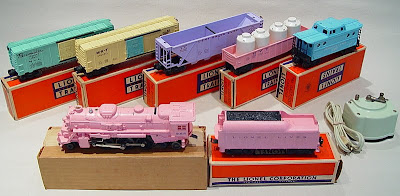Of course that way of knowing is irrational, and every once in a while some rational person tries to help us notice what we actually are. "Where id was, there shall ego be," said Sigmund Freud, and in 1957 the manufacturer of Lionel electric trains made a generous attempt to expand its market by liberating parents from the enslaving infantile fantasy of boy toys for boys, girl toys for girls. Lionel reset its injection molders to bring forth a girl train --
and comedy promptly undid the result. By girls and boys and fathers and mothers, unanimously, the Lady Lionel was laughed right into rarity. According to one collector, "There are stories of hardware stores actually painting these ugly pink trains black just to try to get part of their money back on them" (http://www.ibuyoldtrains.com/Lionel%201587s%20Pink%20Girls%20Train.htm). Comedy assures us that trains always have been black and always will be, and under the protection of that comforting promise we continue growing from unconsciousness into more unconsciousness.
The same oblivion was protecting adults in 1955 and 1956, when the Chrysler Corporation made its own effort to market a boy toy as if it could become a girl toy. The Dodge La Femme made its entrance in pink (for 1955) or lavender (for 1956), and in its first year it came accessorized with a matching pink purse, pink raincoat, and pink umbrella.
Of course the fashion didn't take. For women the pink remained on the car's surface, changing nothing because for most women a car has little presence in fantasy, where color works its infantile magic. For men, on the other hand, the pink penetrated into fantasy all too deep. Nineteen fifty-five wasn't only the year of La Femme; it was also the year of Rebel Without a Cause and The Shrike: a movie about a failed father who wears a frilly apron to wash the dishes, and a movie about a psychiatrist who liberates a failed husband by exorcising his wife with the magic word "castration." If the father of a one-car family were on his way to work in 1955, he wouldn't be driving a car marked with this bleeding stigma.
So La Femme is now a collector's item even rarer than the Lady Lionel train. Except under extraordinary circumstances, it is as vanished from consciousness now as last night's bad dream.
But now consider this even older image as it blazons its still living threat and promise across the page.

The image was seen in 1951 by Weegee, who added the title and the button some fifteen years later. According to Holland Cotter's article in the New York Times,
http://www.nytimes.com/2006/06/09/arts/design/09weeg.html
the photograph's factual history denotes only a couple waiting in line to attend a movie called Colt .45, and the picture of the weapon is nothing but a pass promising free admission to the entertainment. Nineteen fifty-one, we think when our eyes are closed and we're receptive to fantasy: a more innocent time, a happier time. History, sad dead grownup history, would only spoil the dream if it reminded us of what's called real life during the Truman-McCarthy era, three years before Brown v. Board of Education. History would make that sad story even sadder if it were to go still deeper into memory and remind us of what this particular boy toy was actually used for. And so, generally, we don't listen to history.
But Weegee looked at it. After a while he noticed that the color of this particular history was black, and that that color changed everything -- at least for the palette of the future's dreams. This particular artwork was never seen by a viewership until 2006: long after Weegee's own death, long after the slogan "Black power" itself had become history. Nevertheless, the blackness that Weegee saw is still with us. It floods the whole visual field, blurring the distinction between who in this fantasy picture is faceless boy and who is faceless girl. All that remains now of what they once were is the black: a single-color theme designed by the couturier Jude for what he called (in verse 13, King James version) "wandering stars, to whom is reserved the blackness of darkness forever."
"Forever": now there’s a collectible that will never go rare, turn pink, and disappear.



